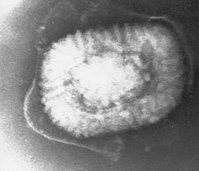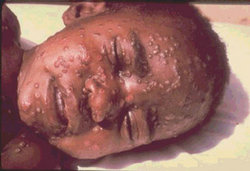Recent events around the world have emphasized the need for policies to deal with biological threats, including smallpox. Developing OR guidelines and suggested courses of action to take when dealing with patients who have smallpox is an important step in establishing an emergency preparedness manual.
When administrators at Walter Reed Army Medical Center, Washington, DC, identified the need for a policy for handling patients with smallpox in the OR, they could find no existing written guidelines or policies. Students in a perioperative nursing course at the hospital were given the assignment of creating a template policy for caring for patients with smallpox in need of surgery. The students developed guidelines based on airborne and contact guidelines from the Centers for Disease Control and Prevention (CDC) regarding methicillin-resistant Staphylococcus aureus (MRSA), tuberculosis (TB), and the variola virus.
THE HISTORY OF SMALLPOX
The oldest known case of smallpox dates back to the twelfth century BC. A recent examination of the mummy of Ramses V of Egypt revealed characteristic smallpox blister scars on its face and torso. (1) In 165 AD, the Roman Empire was devastated by a 15-year smallpox epidemic that killed millions. (2) Europe and Asia also experienced millions of deaths caused by this agent during the Middle Ages. (2)
In the eighteenth century, Sir Jeffery Amherst, the commander-in-chief of British forces, used smallpox as a biological war strategy against Native Americans. The British gave blankets laced with smallpox to Native Americans to reduce their numbers. (3) It is alleged that the same tactic was used against colonists during the American Revolutionary War. (3)
During World War II, British and American scientists investigated using smallpox as a biological weapon. (3) President Richard M. Nixon halted this program in 1969, (3) and an international agreement outlawing the development and production of biological weapons was forged in 1972. (3)
The World Health Organization has been working to eradicate smallpox through vaccination since 1959. (2) The smallpox vaccine was developed by Edward Jenner, MD. Jenner discovered that taking pus from a pustule that was caused by cowpox on the hand of a milkmaid and inoculating it into an incision on the arm led to preventing smallpox. (1) The vaccine he developed has been successfully used to eradicate smallpox; the last natural smallpox outbreak was in Somalia in 1977. (2)
SMALLPOX CONCERNS TODAY
Although the 1972 Biological Weapons Treaty, which limits the production of biological warfare agents, was signed by 143 nations, some countries still are manufacturing biological weapons. (4) In 1991, the United States and the former Soviet Union mutually agreed on cross-inspection for smallpox production. Initially, US inspectors found traces of biowarfare research in Soviet laboratories, but after political leaders in the Soviet Union realized the United States truly had abandoned stockpiles of smallpox, they eradicated their supply. (4)
Since 1983, all remaining supplies of the smallpox virus reportedly have been turned over for safekeeping to two designated facilities: (4) the CDC, Atlanta, and Vector Laboratories, Novosibirsk, Siberia. (5) It is speculated, however, that China, Libya, South Africa, Israel, and Pakistan still are harboring secret stockpiles of the virus. (4) This is not surprising because biological weapons are inexpensive. It costs more than $2,000 for conventional weapons to produce the same mass casualties per square kilometer as it does for only $1 in biological weapons, such as smallpox. (6) Smallpox also is effective as a weapon because many members of the younger generation have not received vaccinations against it.
It is extremely important for health care personnel to prepare for a potential smallpox outbreak. Nurses and physicians are the first line of defense in recognizing and treating smallpox. Hospitals must have qualified personnel who are prepared to efficiently and effectively diagnose and treat infected patients to contain and prevent spread of the disease.
The best way to prevent mass confusion in an outbreak situation is for treatment facilities to be ready when there is an occurrence and inform members of the public about the best course of action. In the OR, personnel must understand and know how to carry out protocols already set in place. As in any emergency or disaster situation, it is a priority for all personnel involved to know the applicable procedures and act immediately in the correct manner.
CHARACTERISTICS OF SMALLPOX
Smallpox spreads easily from person to person via droplet nuclei, it takes three to four days for the virus to spread, and a second viremia occurs 12 to 14 days later. Symptoms include high fever, malaise, severe abdominal pain, and, in some cases, delirium. These symptoms occur 13 to 14 days after exposure and last between two and four days. A widespread rash becomes vesicular and then pustular. A concentration of vesicles on the face is typical and causes blindness in many victims. (5)
In a classic case of smallpox, a vaccinated person has a 3% fatality rate and an unvaccinated person has a 30% fatality rated The airborne and contact characteristics of this disease require strict isolation for personnel treating infected individuals, and vaccination is required as soon as possible. It is recommended that all people who have been exposed be vaccinated as soon as possible, preferably within seven days after exposure, to prevent the disease. (7) Patients with smallpox present a threat to perioperative staff members, as they do to everyone who comes in contact with them, because of the virus' easy transmission and devastating results. An infected individual is considered contagious until the last smallpox scab falls off. (4)
When a patient is suspected or confirmed to have smallpox, the CDC and a state epidemiologist or other authorized state official must be notified immediately. The infectious disease department for the hospital involved is responsible for communication between the hospital, the CDC, and state officials. State officials may designate a person or persons to coordinate all activities related to isolation or quarantine with federal authorities and to care for specific groups designated by the CDC.
At this time, a hospital capable of caring for patients with smallpox will be designated. If transportation via ambulance is required, special precautions for the ambulance and ambulance crew members need to be followed. Only vaccinated personnel should transport patients with smallpox, and they should wear a gown, gloves, shoe covers, and an N95 particulate respirator mask approved by the National Institute for Occupational Safety and Health. Unneeded supplies should be removed from the ambulance, and patients should be covered in linen sheets and wear surgical masks. After transport is complete, all personal protective equipment (PPE) and waste items should be placed in biohazard bags, and the ambulance should not be used for another transport until it is fully decontaminated. (8) It is understood that if one patient is positive for smallpox, many more may follow. In the event that a hospital receives a patient in need of emergency surgery for the sustainment of life, limb, or eyesight without the possibility of transfer to a designated facility, the guidelines in Table 1, which were developed by the students at Walter Reed Army Medical Center, can prepare perioperative staff members and patients for surgery.
THE NECESSITY OF TRAINING
Procedures for handling and containing smallpox should be in place for the entire hospital as well as the OR in the event of a smallpox outbreak. If staff members are trained about smallpox during mass casualty or biochemical training, their reaction to an actual event should be better organized and will not jeopardize patient care. Training also can help prevent fear or hysteria in health care workers.
The threat of smallpox is alarming, and the world situation today is such that care providers must be ready. History has proven that it is possible for an outbreak of infectious disease, including smallpox, to occur even without mankind's intervention. Policies and guidelines in the workplace will facilitate management of a smallpox incident.
Editor's note: The opinions or assertions contained in this article are the private views of the authors and are not to be construed as official or as reflecting the views of the US Army Medical Department or the Department of Defense.
NOTES
(1.) C Flight, "Smallpox: Eradicating the scourge," BBC History, http://www.bbc.co .uk/history/discovery/medicine/smallpox_02 .shtml (accessed 21 June 2004).
(2.) R Trupin, "Smallpox: Diseases associated with biological warfare," Wild Iris Medical Education, http://www.nursing ceu.com/NCEU/courses/smallpox/ (accessed 29 May 2003).
(3.) C Flight, Silent weapon: Smallpox and biological warfare," BBC: The Cold War, http://www.bbc.co.uk/history/war/coldwar/pox _weapon_01.shtml (accessed 11 Aug 2004).
(4.) S Brownlee, "Everything you ever wanted to know about smallpox bioterrorism, http://www.mcrcola.com/2001/nov/14 /smallpox.htm (accessed 7 July 2003).
(5.) D J McClain, "Smallpox," in Textbook of Military Medicine: Medical Aspects of Chemical and Biological Warfare, Virtual Naval Hospital, http://www.vnh.org/Med AspChemBioWar/chapters/chapter_27.htm (accessed 21 June 2004).
(6.) M J Murray, "Chemical weapons compromise provider safety: Japanese satin attacks illustrate huge potential risks," The Anesthesia Patient Safety Foundation, http://www.apsforg/newsletter/2002/spring/12 chemicalweapons.htm (accessed 21 June 2004).
(7.) US Army Medical Research Institute of Infectious Diseases, "Smallpox," in Medical Management of Biological Casualties Handbook, Virtual Naval Hospital, http://www.vnh.org /BIOCASU/13.html (accessed 21 June 2004).
(8.) "Draft guide C, part 1: Infection control measures for healthcare and community settings," Centers for Disease Control and Prevention, http://www.bt.cdc.gov/agent /smallpox/response-plan/files/guide-c-part 1.doc (accessed 21 June 2004).
RESOURCES
A Laundry Manager's Guide to Washroom Formulas (South Holland, Ill: Gurtler Chemicals, Inc, December 1992).
"Infection control," in Anesthesia and Operative Service Policies and Procedures (Washington, DC: Walter Reed Army Medical Center, June 2002).
"Strategy for managing TB patients and preventing airborne transmission in operating rooms," Draft policy 4, 358 Table 14 (Atlanta: National Center for Infectious Diseases, Centers for Disease Control and Prevention, March 2001).
Centers for Disease Control and Prevention, "Guide F--Environmental control of smallpox virus," in Smallpox Response Plan (Atlanta: Centers for Disease Control and Prevention, March 20, 2003).
"Emergency management program: Standard operating procedure: Smallpox," Department of Veterans Affairs, http: //www1.va.gov/emshg/apps/emp/7_2_sop_all/ smallpox_sop.htm (accessed 21 June 2004).
"Frequently asked questions about TB protocols at Duke Hospital and Clinics," Duke Occupational and Environmental Safety Office, http://www.safety.duke.edu/Bio Safety/TBFAQ/portablehepas.asp (accessed 21 June 2004).
"HCSA emergency/disaster linen management plan," Harborview Medical Center, http://depts.washington.edu/ictrain /DisasterPlanLinenIC.doc (accessed 30 Aug 2004).
"Management of a patient with tuberculosis (TB)," in Infection Control Policy Guide (Washington, DC: Walter Reed Army Medical Center, Aug 15, 2002).
"Smallpox disease overview," Centers for Disease Control and Prevention, http: //www.bt.cdc.gov/agent/smallpox/overview/dis ease-facts.asp (accessed 21 June 2004).
CPT Amy Beasley, RN, BSN, is a nurse at Walter Reed Army Medical Center, Washington, DC.
CPT Shelley Kenenally, RN, BSN, is a nurse at Walter Reed Army Medical Center, Washington, DC.
CPT Natalie Mickel, RN, BSN, is a nurse at Brooke Army Medical Center, Fort Sam Houston, San Antonio, Tex.
CPT Kija Korowicki, RN, BSN, is a staff nurse at DeWitt Army Medical Center, Fort Belvoir, Alexandria, Va.
MAJ Sue McCann, RN, BSN, is a nurse at Walter Reed Army Medical Center, Washington, DC.
1LT Julie Arundell, RN, BSN, is a nurse at Evans Army Community Hospital, Fort Carson, Colorado Springs, Colo.
CPT Wylie Simmons, RN, BSN, is a nurse at Bayne-Jones Army Community Hospital, Fort Polk, Leesville, La.
CPT Harold Williams, RN, BSN, is a nurse at Walter Reed Army Medical Center, Washington, DC.
COPYRIGHT 2004 Association of Operating Room Nurses, Inc.
COPYRIGHT 2004 Gale Group



